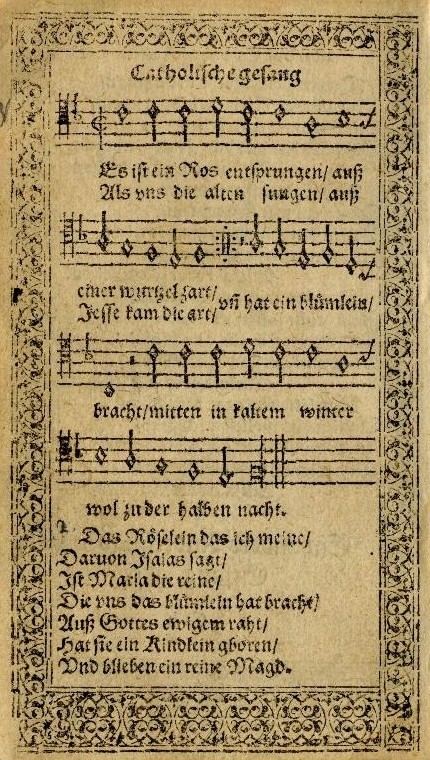Language German | Occasion Christmas | |
 | ||
Es ist ein Ros entsprungen (lit., "A rose has sprung up"), most commonly translated in English as Lo, How a Rose E'er Blooming, and sometimes appearing as A Spotless Rose, is a Christmas carol and Marian Hymn of German origin, of varying length and translation, that has its roots in an unknown author prior to the 17th century. Expressing the fulfillment of the prophecy of Isaiah 11:1, the original two verses (to which others have been added, in German and translation since the 19th century) present a narrative of Mary, the mother of Jesus as a rose that has sprung up from the lineage of Jesse, to bring forth the child, "das Blümlein" (lit., the floweret), while remaining pure. The song has been covered repeatedly throughout modern times, e.g., by Mannheim Steamroller on A Fresh Aire Christmas (1988) and Sting on If on a Winter's Night (2009), and has made its way into a variety of feature film soundtracks, including Love Story (1970) and The Time Traveler's Wife (2009).
Contents
History
The text is thought to be penned by an anonymous author expressing fulfillment of the prophecy of Isaiah 11:1 The piece first appeared in print in the late 16th century. The hymn has been used by both Catholics and Protestants, with the focus of the song being Mary or Jesus, respectively. In addition, there have been numerous versions of the hymn, with varying texts and lengths. In 1844, the German hymnologist Friedrich Layriz added three more stanzas, the first of which, Das Blümelein so kleine, remained popular and has been included in Catholic hymnals.
The tune most familiar today appears in the Speyer Hymnal (printed in Cologne in 1599), and the familiar harmonization was written by German composer Michael Praetorius in 1609.
The English translation "Lo, How a Rose E'er Blooming" was written by Theodore Baker in 1894. A translation of the first two verses of the hymn as "A Spotless Rose" was written by Catherine Winkworth and this was set as a SATB anthem by Herbert Howells in 1919 and Philip Ledger in 2002.
Another Christmas hymn, "A Great and Mighty Wonder", is set to the same tune as this carol and may sometimes be confused with it. It is, however, a hymn by St. Germanus, (Μέγα καὶ παράδοξον θαῦμα), translated from Greek to English by John M. Neale in 1862. Versions of the German lyrics have been mixed with Neale's translation of a Greek hymn in subsequent versions such as Percy Dearmer's version in the 1931 Songs of Praise collection.
In music
The tune was used by Johannes Brahms as the base for a chorale prelude for organ, later transcribed for orchestra by Erich Leinsdorf, and by Hugo Distler as the base for his 1933 oratorio Die Weihnachtsgeschichte (The Christmas Story). Jan Sandström wrote in 1990 Es ist ein Ros entsprungen for two choirs a cappella, which incorporates the setting of Praetorius in choir one. Weihnachtsmusik (1921) for two violins, cello, piano and harmonium by Arnold Schoenberg is a short fantasy on the tune.
Modern interpretations
Some notable performances by contemporary popular artists include:
